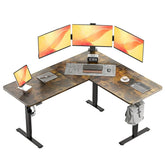Why Every Office Needs a Standing Desk: The Science Behind Sit-Stand Workstations
In recent years, standing desks have moved beyond being workplace novelties to become staples of modern office wellness programs. What was once a trend, dismissed by some as a passing fad, has solidified as a health necessity, backed by mounting research that paints a clear picture: prolonged sitting is a significant risk factor for a host of chronic health issues.
Health experts have coined prolonged sitting as "the new smoking," a stark phrase that underscores its far-reaching risks. Studies from esteemed institutions like the Mayo Clinic and Harvard Medical School provide troubling statistics: spending eight or more hours a day seated increases the likelihood of heart disease by 147%, raises obesity risk by altering metabolic rates, and contributes to chronic lower back pain by placing constant pressure on spinal discs. For office workers, who often log 40-plus hours weekly at their desks—with many exceeding that during busy periods—these statistics are not just numbers but urgent calls to action.
A height-adjustable desk emerges as a practical, accessible solution by enabling users to switch between sitting and standing throughout the workday. This simple act of alternating positions disrupts the harmful cycle of prolonged inactivity. Research published in the American Journal of Preventive Medicine found that employees using standing desks reported a 32% reduction in lower back pain after just one month of regular use. The improvement is not coincidental; it stems from increased movement that stimulates blood flow, which in turn delivers more oxygen to muscles and the brain, reducing stiffness and fatigue.
This enhanced circulation translates to tangible, bottom-line benefits for workplaces. Employees consistently report higher energy levels when using standing desks, with fewer of the mid-afternoon slumps that can derail productivity for hours. A 2023 study by the Society for Human Resource Management (SHRM) quantifies this impact: companies that equipped their offices with standing desks saw a 15% decrease in sick days and a 12% increase in task completion rates. For employers, the math becomes clear: the upfront cost of investing in standing desks is quickly offset by a healthier, more engaged, and more productive workforce.

Not all standing desks are created equal, however, and choosing the right models is crucial to maximizing their benefits. When selecting standing desks for an office, prioritize those with electric adjustment mechanisms that operate smoothly and quietly—loud motors can be distracting in open workspaces. Programmable height presets are another key feature, allowing users to save their preferred sitting and standing positions, reducing the time spent adjusting and minimizing interruptions to workflow. Sturdy construction is also non-negotiable; quality desks should support at least 150 pounds to accommodate multiple monitors, laptops, printers, and everyday office supplies without wobbling or instability, which can itself cause discomfort.
The flexibility of standing desks extends beyond physical health, catering to different work styles and tasks. Deep analytical work or focused writing that requires sustained concentration may still benefit from seated positions, where the body can relax into a state of calm focus. Conversely, team meetings, phone calls, or creative brainstorming sessions often feel more dynamic and collaborative when participants stand, encouraging more active participation and faster idea exchange. This adaptability fosters a more engaging work environment, where employees aren’t confined to a single posture for hours on end, breaking the monotony that can lead to disengagement.
Mental well-being, too, sees significant improvements with the use of standing desks. Standing has been shown to increase endorphin levels—the body’s natural mood boosters—which help reduce stress and anxiety. Employees frequently note feeling more alert and motivated when they have the option to alternate positions, contributing to a more positive, energetic office culture. This shift in mood can have ripple effects, enhancing collaboration, reducing conflicts, and improving overall job satisfaction, which in turn lowers turnover rates.
Implementing standing desks successfully in an office requires more than just purchasing the equipment; it demands proper guidance and support for employees. Employers should offer ergonomic training sessions to teach staff how to set up their desks correctly, whether in sitting or standing positions. For standing, elbows should form a 90-degree angle at the keyboard, and monitors should be positioned so the top third of the screen aligns with eye level to prevent neck strain—a common issue when screens are too low. A gradual transition is recommended to avoid muscle fatigue, starting with 10-15 minutes of standing each hour and increasing incrementally as the body adapts, typically over two to three weeks.

Additional accessories can further enhance the standing desk experience. Anti-fatigue mats provide cushioning for those unaccustomed to standing for extended periods, reducing pressure on feet, ankles, and knees. Footrests can offer support during seated intervals, promoting better posture. Encouraging regular stretching breaks—even just a minute or two of simple stretches for the legs, back, and shoulders—further supports the transition to more active work habits and complements the benefits of standing desks.
As awareness of workplace health and wellness continues to grow, standing desks have evolved from optional perks offered by forward-thinking companies to essential investments for any organization that values its employees’ well-being. They address a critical modern health concern—prolonged sitting—that is inherent to office work, while delivering measurable benefits for both employees and employers alike. By prioritizing movement and flexibility, standing desks help create work environments that support long-term health, sustained productivity, and overall well-being, making them not just a wise investment but a necessary one in today’s workplace.
Ready to find the perfect standing desk for your workspace? Explore our curated collection of electric and manual standing desks at vvenace.com to discover ergonomic solutions that fit your needs and budget.



